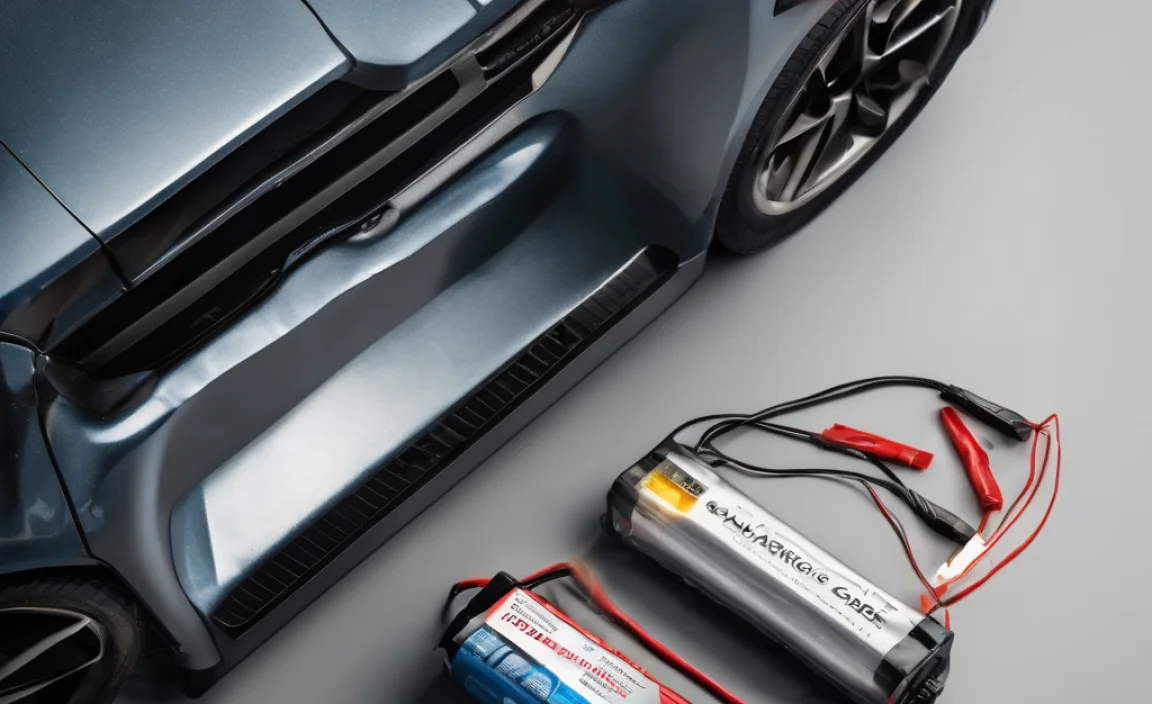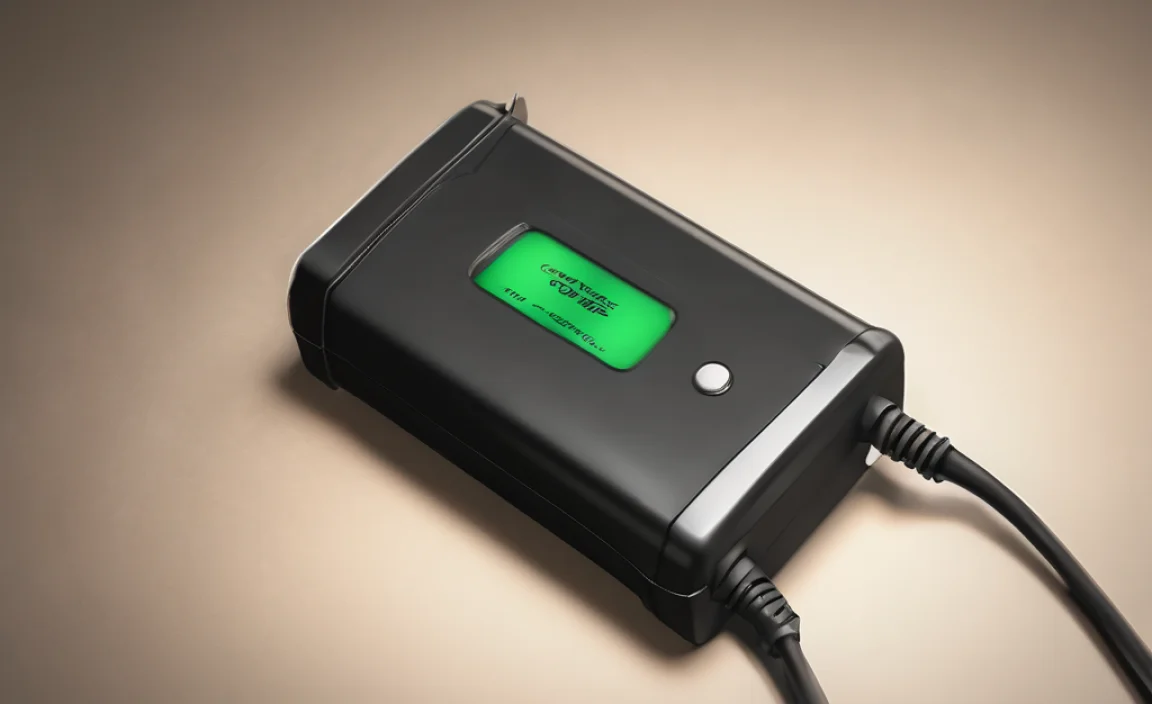Quick Summary
Finding the right battery for a Scout scooter is simple when you know what to look for. This guide helps you choose the best power source, understanding types, maintenance, and replacement, ensuring your scooter runs reliably. Get essential power for your adventures!
Is your Scout scooter suddenly losing power or struggling to start? A reliable battery is the heart of your electric ride. When it falters, your adventures stop. Don’t worry, keeping your scooter powered up is easier than you think. We’ll walk through everything you need to know, from picking the right battery to keeping it in top shape.
This guide will help you understand your Scout scooter’s battery needs. We’ll break down different battery types, explain how to care for them, and show you when it’s time for a replacement. Let’s get you back to cruising with confidence!
Understanding Your Scout Scooter Battery
The battery in your Scout scooter is an electric vehicle’s engine. It stores the energy that powers the motor, lights, and all other electric components. Just like a car battery needs to be strong to start the engine, your scooter’s battery needs to be healthy to give you a good ride. For Scout scooters, these are typically sealed lead-acid (SLA) batteries, though some might use lithium-ion. Understanding the basics of these batteries will help you make informed decisions about maintenance and replacement.
Why Battery Health Matters
A healthy battery means more range, quicker acceleration, and reliable performance. A weak or old battery can lead to:
- Reduced travel distance on a single charge.
- Slower speeds and poor acceleration.
- Difficulty starting or holding a charge.
- Complete failure, leaving you stranded.
Types of Scout Scooter Batteries
Most Scout scooters come with Sealed Lead-Acid (SLA) batteries. These are a common and cost-effective choice for many electric vehicles. However, newer models or aftermarket upgrades might offer lithium-ion batteries.
Sealed Lead-Acid (SLA) Batteries
SLA batteries are the workhorses of many electric scooters. They are durable and relatively inexpensive. They don’t require maintenance like older flooded lead-acid batteries because they are sealed. This means you don’t need to add water.
- Pros:
- Lower upfront cost.
- Widely available and compatible.
- Robust and can handle frequent use.
- Cons:
- Heavier than lithium-ion batteries.
- Shorter lifespan compared to lithium-ion (typically 2-4 years).
- Can be sensitive to deep discharges, which reduce their lifespan.
An excellent resource for understanding battery technology, including lead-acid types, is the U.S. Department of Energy’s guide on EV batteries.
Lithium-Ion (Li-ion) Batteries
Lithium-ion batteries are becoming more popular due to their advantages. They are lighter, hold more energy for their weight, and generally last longer.
- Pros:
- Lighter weight, improving scooter maneuverability.
- Higher energy density, leading to longer range.
- Longer lifespan (can last 1,000+ charge cycles).
- Faster charging times.
- Less affected by deep discharges.
- Cons:
- Higher upfront cost.
- Require specific chargers and battery management systems (BMS) for safety.
- Performance can degrade in very cold temperatures.
For a comparison of different battery chemistries, including lithium-ion, you can check out Dupont’s guide on lithium-ion battery types.
Identifying Your Current Battery
Knowing what battery your Scout scooter uses is key. Look for labels on the battery itself. It will usually indicate the voltage (V) and amp-hour (Ah) rating. These numbers tell you how powerful the battery is and how long it can supply power. For example, a 24V 10Ah battery will provide more power and run for longer than a 24V 5Ah battery.
A common setup for many Scout scooters is a 24V system, often with two 12V batteries wired in series. Always check your scooter’s manual or the battery itself for exact specifications.
Choosing the Right Replacement Battery
When it’s time to replace your Scout scooter battery, selecting the correct one is crucial for performance and safety. Using the wrong type or specifications can damage your scooter or lead to a poor riding experience.
Key Specifications to Match
- Voltage (V): This is the most critical specification. Your new battery must match the original voltage (e.g., 24V). If your scooter uses two 12V batteries wired in series, you’ll need two 12V batteries.
- Amp-Hours (Ah): This rating determines the battery’s capacity – how much energy it stores. A higher Ah rating means longer run time. You can usually opt for a higher Ah battery if it fits physically and your charger can handle it, giving you extended mileage.
- Physical Size and Terminal Type: The new battery must fit in the designated space on your scooter. Also, ensure the terminal connectors (the posts where wires attach) match your scooter’s wiring.
- Chemistry: If your scooter came with SLA, it’s generally safest to replace it with another SLA battery of the same voltage. If you want to upgrade to Li-ion, ensure your scooter’s electronics and charger are compatible or that you are replacing the entire system.
Where to Buy Scout Scooter Batteries
You have several options for purchasing replacement batteries:
Authorized Dealers and Service Centers
This is often the safest bet. They will have the exact specifications for your Scout scooter model and can ensure compatibility.
Online Retailers
Websites like Amazon, eBay, or specialized battery stores offer a wide selection. Be sure to check reviews, seller reputation, and return policies. Always double-check the specifications against your scooter’s requirements.
Local Battery Stores
Many areas have dedicated battery shops that can test your old battery and help you find a suitable replacement.
Compatibility Check Table
Here’s a quick guide to help you match common battery specifications. Always refer to your scooter’s manual for definitive information.
| Scooter Model (Example) | Original Battery Voltage | Original Battery Ah (Typical) | Recommended Replacement Voltage | Recommended Replacement Ah (Allow range) | Battery Chemistry |
|---|---|---|---|---|---|
| Scout 200 | 24V (two 12V) | 7Ah – 12Ah | 24V (two 12V) | 7Ah – 15Ah | SLA (AGM is common) |
| Scout 300 | 36V (three 12V) | 10Ah – 15Ah | 36V (three 12V) | 10Ah – 18Ah | SLA (AGM is common) |
| Scout 400 (Li-ion option) | 48V (Li-ion pack) | 15Ah – 20Ah | 48V (Li-ion pack) | 15Ah – 25Ah | Lithium-ion |
Note: Ah ratings can often be increased if the physical size and weight are acceptable and the charger is suitable.
Maintaining Your Scout Scooter Battery for Longevity
Proper maintenance can significantly extend the life of your Scout scooter’s battery, saving you money and ensuring reliability. Even sealed batteries benefit from good care.
Charging Best Practices
The charger that came with your scooter is designed precisely for its battery system. Using the wrong charger can damage the battery or, worse, be a fire hazard.
- Use the Correct Charger: Always use the charger specifically designed for your Scout scooter’s battery type and voltage.
- Full Charges: For SLA batteries, it’s generally best to charge them fully after each ride, especially if you’ve used a significant portion of their capacity. Don’t leave them partially charged for extended periods.
- Avoid Overcharging: Modern chargers have safety features to prevent overcharging, but it’s still good practice to disconnect the charger once the indicator shows the battery is full.
- Charge in a Ventilated Area: While SLA batteries are sealed, they can vent small amounts of gas during charging, especially if there’s an issue. Always charge in a well-ventilated space, away from sparks or open flames.
- Charging Temperature: Avoid charging batteries in extreme temperatures. Very cold or very hot conditions can affect charging efficiency and battery health.
A helpful guide on battery charging can be found on the Battery University website, which offers in-depth information on charging techniques for various battery types.
Storage and Seasonal Care
If you store your Scout scooter for an extended period (e.g., during winter), proper battery care is vital.
- Charge Before Storage: Fully charge the battery before putting the scooter into storage.
- Periodic Top-Up: SLA batteries lose charge over time. If storing for more than a month, check the charge level and top it up periodically. Some battery tenders can maintain a charge without damaging the battery.
- Temperature: Store the scooter and battery in a cool, dry place. Extreme temperatures during storage can degrade the battery.
- Disconnect Battery (Optional): For very long storage, some people disconnect the battery from the scooter to prevent any slow drain from the scooter’s electronics.
Environmental Factors
- Temperature: Extreme heat is the enemy of batteries, shortening their lifespan. Try to avoid leaving your scooter in direct hot sun for long periods. Extreme cold can temporarily reduce performance but is less damaging long-term than heat.
- Vibration: Excessive vibration can loosen internal components, especially in SLA batteries. Ensure your scooter is ridden on suitable surfaces and that battery mounts are secure.
When to Replace Your Scout Scooter Battery
Batteries don’t last forever. Recognizing the signs that it’s time for a replacement will save you from unexpected breakdowns.
Signs of a Failing Battery
- Reduced Range: If you’re getting significantly less distance on a full charge than you used to, the battery capacity has likely diminished.
- Slow Performance: The scooter feels sluggish, and acceleration is weaker, even with a full charge.
- Difficulty Holding Charge: The battery drains very quickly, even after being fully charged.
- Physical Swelling or Leaking: For SLA batteries, a swollen case or any signs of leakage are serious indicators of a battery failure. Do not use or charge a battery showing these signs.
- Indicator Lights Behaving Strangely: Some scooters have battery indicators. If they show a full charge but the performance is poor, the battery is likely failing.
- Battery Age: Most SLA batteries have a lifespan of 2-4 years. If yours is approaching or past this age, it’s operating on borrowed time.
Testing Your Battery
If you’re unsure, you can test your battery’s health.
- Voltmeter Test: With the battery fully charged and disconnected from the scooter, connect a voltmeter to the terminals. Check the voltage reading. For a 12V SLA battery, a fully charged voltage is typically around 12.6V to 12.8V. If the voltage is significantly lower (e.g., below 12V per 12V battery in a 24V system), the battery is likely weak.
- Load Testing: A more accurate test involves a load tester, which simulates the demands placed on the battery during use. Many auto parts stores or battery shops can perform this test for free.
How to Replace Your Scout Scooter Battery (DIY Guide)
Replacing the battery in your Scout scooter is a manageable DIY task if you follow safety precautions. Always consult your scooter’s manual for model-specific instructions.
Safety First!
Batteries contain corrosive acid and can produce flammable gases.
- Wear Protective Gear: Always wear safety glasses and gloves.
- Work in a Ventilated Area: Ensure good airflow.
- No Sparks or Flames: Keep flammable materials away.
- Avoid Short Circuits: Never let metal tools touch both battery terminals at the same time.
- Handle with Care: Batteries can be heavy. Lift with your legs.
Tools You’ll Need
The exact tools depend on your scooter, but commonly needed items include:
- Replacement battery (correct voltage and Ah, matching physical size).
- Socket set or wrench set (to remove battery retaining brackets).
- Screwdrivers (if panels need to be removed).
- Battery terminal cleaner or wire brush.
- Anti-corrosion spray or grease for terminals.
- Rag or paper towels.
Step-by-Step Replacement Process
1. Access the Battery Compartment:
Most scooters have a compartment accessible by removing a panel or lid. This might require unscrewing a few bolts or fasteners. Refer to your manual if unsure.
2. Disconnect the Old Battery:
Remember the phrase “Negative before Positive, and Positive before Negative” for disconnecting and connecting.
Identify the positive (+) and negative (-) terminals.
Using your wrench or socket, loosen and remove the cable from the negative (-) terminal first. Set the cable aside so it cannot accidentally touch the battery.
Next, loosen and remove the cable from the positive (+) terminal.
If there’s a battery retaining bracket or strap, remove it now.
3. Remove the Old Battery:
Carefully lift the old battery out of its compartment. Be mindful of its weight. If it’s a multi-battery setup, remove them one by one.
4. Clean the Battery Tray and Terminals:
Use a rag to wipe down the battery tray.
Use a wire brush or terminal cleaner to clean any corrosion from the cable connectors. Clean battery terminals are essential for good electrical contact.
5. Install the New Battery:
Place the new battery into the compartment, ensuring it sits securely. If it’s a multi-battery system, ensure they are oriented correctly for wiring (usually in series for increased voltage).
Reinstall any retaining brackets or straps to keep the battery firmly in place.
6. Connect the New Battery:
This is the reverse of disconnecting.
Attach the cable to the positive (+) terminal first and tighten it securely.
Next, attach the cable to the negative (-) terminal and tighten it.
Apply a small amount of anti-corrosion spray or dielectric grease to the terminals to prevent future corrosion.
7. Reassemble the Scooter:
Replace any panels or covers you removed.
8. Initial Charge:
* Connect your appropriate charger and perform an initial full charge before riding. Monitor the charging process.
For a visual guide, searching for “Scout scooter battery replacement” on video platforms like YouTube can provide helpful demonstrations specific to various models.
Disposing of Old Batteries
Lead-acid batteries are hazardous waste and must be disposed of properly. Do not throw them in regular trash.
- Recycling Centers: Most local recycling centers accept lead-acid batteries.
- Retailers: Many places that sell batteries will take back old ones for recycling, often for free or a small fee.
- Scrap Metal Yards: Some may accept them.
Proper recycling is important for environmental protection. You can find information on battery recycling through resources like the U.S. Environmental Protection Agency (EPA) website.
Troubleshooting Common Battery Issues
Even with the best care, you might encounter battery problems. Here’s how to tackle a few common ones.
Problem: Scooter won’t turn on at all.
- Possible Causes: Dead battery, loose connections, blown fuse.
- What to Check:
- Ensure the battery is charged. Try charging it fully.
- Check that all battery cables are tight and free of corrosion.
- Locate and inspect the main fuse for your scooter (check manual for location).



